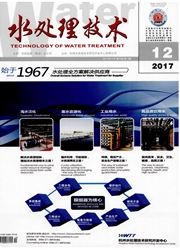

 中文摘要:
中文摘要:
为了解析浊度与腐植酸共存时的超滤膜污染行为,分别进行了浊度、腐植酸及浊度-腐植酸共混溶液的膜污染实验,使用原子力显微镜结合自制膜材料探针和污染物探针定量测定了不同浊度、腐植酸比共混污染物与膜及浊度-腐植酸之间的微观作用力,并系统考察了不同污染膜的表面形貌特点。结果表明,浊度物质-腐植酸之间的力明显大于腐植酸-膜之间的作用力,使得浊度物质与腐植酸共存时,腐植酸分子优先吸附在浊度物质表面,降低了其与膜的接触机率。且浊度物质的尺寸远远大于所使用超滤膜的平均孔径,所以浊度物质对腐植酸的优先吸附使得腐植酸进入膜孔内的机率减小,相应的膜污染减轻。此外,与腐植酸污染膜相比,浊度-腐植酸污染膜表面的污染层结构较为疏松。
 英文摘要:
英文摘要:
For better understanding the fouling behavior of ultrafiltration membrane by the mixtures of turbidity material and humic acid(HA), fouling experiments with turbidity water, HA and turbidity/HA mixtures were carried out with PVDF ultrafiltration membranes. Besides the surface morphology of clean and fouled-membranes, the adhesion forces of turbidity/HA mixtures-membrane and HA-turbidity were measured by atomic force microscopy(AFM) in conjunction with self-made membrane material and foulant-coated probe, respectively. Results show that the turbidity-HA interaction force was significantly stronger than PVDF-HA interaction force, suggests that the HA was adsorbed preferentially on the surface of turbidity, which reduced the risk of HA contact with membrane. Upon considering the size of turbidity material was much larger than the average pore size of the ultrafiltration membrane,the preferential adsorption of humic acid on the surface of turbidity material reduced the risk of HA pass into membrane pores, and membrane fouling was mitigated. Moreover, the HA-fouled membrane surface looks more compact than that for HA/turbidity mixture-fouled membrane.
 同期刊论文项目
同期刊论文项目
 同项目期刊论文
同项目期刊论文
 Preparation of PVDF membranes via the low-temperature TIPS method with diluent mixtures: The role of
Preparation of PVDF membranes via the low-temperature TIPS method with diluent mixtures: The role of Understanding PVDF ultrafiltration membrane fouling behavior through model solutions and secondary w
Understanding PVDF ultrafiltration membrane fouling behavior through model solutions and secondary w Preparation of PVDF hollow fiber ultrafiltration membrane via phase inversion/chemical treatment met
Preparation of PVDF hollow fiber ultrafiltration membrane via phase inversion/chemical treatment met Study on the effect of modified PVDF ultrafiltration membrane for secondary effluent of urban sewage
Study on the effect of modified PVDF ultrafiltration membrane for secondary effluent of urban sewage The effect of PVDF concentration on PVDF/woven tube composite membranes and the application of compo
The effect of PVDF concentration on PVDF/woven tube composite membranes and the application of compo ExperimentalStudy of Adhesion Properties Between Membrane Surface and Humic Acid DuringMicrofiltrati
ExperimentalStudy of Adhesion Properties Between Membrane Surface and Humic Acid DuringMicrofiltrati Mechanism analysis of membrane fouling behavior by humic acid usingatomic force microscopy: Effect o
Mechanism analysis of membrane fouling behavior by humic acid usingatomic force microscopy: Effect o Polyvinylidene fluoride/poly(ethylene-co-vinyl alcohol) blended membranes and a systematicinsight in
Polyvinylidene fluoride/poly(ethylene-co-vinyl alcohol) blended membranes and a systematicinsight in Enhancement and Mitigation Mechanisms of Protein Fouling of Ultrafiltration Membranes underDifferent
Enhancement and Mitigation Mechanisms of Protein Fouling of Ultrafiltration Membranes underDifferent 期刊信息
期刊信息
